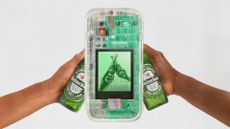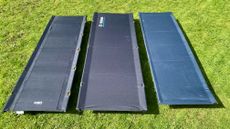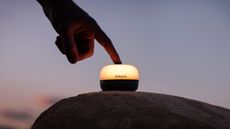Put the Goal Zero Nomad 20 solar charger up against something like the BioLite SolarPanel10+ and it immediately seems a step-down. After all, where's the built-in battery of its foldable, travel-friendly rival solar panel? However, what the Goal Zero Nomad 20 lacks in a built-in battery, it makes up for in form factor and versatility, promising to convert sunshine into an impressive 20W charge for any connected portable power station and 20W for a smartphone.
Salt Lake City-based Goal Zero has been a big name in outdoor power for years and sells everything from small portable batteries and solar panels like the Nomad 20 to large portable power stations and solar generators. Its appears in our best solar charger ranking, alongside its step-down Goal Zero Nomad 10 solar panel and Venture 75 portable battery. Read on for our full Goal Zero Nomad 20 review.
Goal Zero Nomad 20 solar charger review: price and release date
The Nomad 20 originally went on sale in March 2020 alongside the Nomad 10 and Nomad 50 solar panels. It sells on the Goal Zero website for UK£149.95 / US$149.95, which is around AUS$189.
Goal Zero Nomad 20 solar charger review: design
The Goal Zero Nomad 20 is foldable and it's durable. It's effectively three solar panels in one, but packs down to 1kg/2.28 lbs. That makes it really easy to travel with. With a kickstand, it's also a cinch to position when skies are clear.
Goal Zero Nomad 20 solar charger specs
Power: 20W
Size folded: 292 x 19 x 32 mm / 11.5 x 7.4 x 1.25"
Size unfolded: 292 x 553 x 19mm /11.5 x 21.7 x 0.75"
Weight: 1kg / 2.28 lbs
Connections: 8mm Solar Port, USB-A
Battery: N/A
The solar cells themselves are presented within a tough plastic panel that is slightly flexible, but also highly durable. On the back of the solar panels there's a soft fabric covering.
Around the back of the centre solar panel is where you'll find a fold out kickstand, but also a built-in 8 mm Solar Port cable that stretches a whopping 180 centimetres/6ft. and can send 20W into a portable power station. It's there so you can plug the Nomad 20 directly into one of Goal Zero's portable power stations, gradually replenishing a camp's main power source using sunshine alone. So the Nomad 20 isn't not just for smartphones. Alongside that you'll find an 8 mm input for daisy-chaining the Nomad 20 to other solar panels as well as a USB 2.0 port that's rated 5V/2.1-amp. It can put 10.5W into a gadget. You can therefore attach any cable that terminates in USB, though typically that's going to be a universal cable that can charge whatever gadgets you need to refuel on a trip. Sadly no such cable is supplied with the Nomad 20.

Goal Zero Nomad 20 solar charger review: features
If the sun is shining then the Nomad 20 will put a significant charge into your smartphone, tablet or whatever else needs a top-up.
That kickstand is useful for propping up the Nomad 20 out in the sunshine, but it also proves useful for securing to the side of a backpack when hiking. The four corners of the folded out solar panel have small cut outs that can be used to secure the Nomad 20 wherever you want to use it.
However, to get maximum power to a solar panel it needs to be positioned face onto the Sun. If that's not the case, as much as 30% of the potential charge produced can be lost. While some solar panels include a small sundial so that you can reposition actually, to face the Sun, you don't get that on the Nomad 20. It does mean you have to make a judgement call every hour or so and slightly reposition it.

Goal Zero Nomad 20 solar charger review: performance
The Nomad 20 is very well designed. Its natural position is to be folded up, so it stays flat when not in use. When you unfurl it outdoors, the three solar panels more or less stay flat, but you do sometimes have to wedge the bottom corners into the ground to get them as straight as possible.
In our tests in mixed conditions it took a full 12 hours – most of it sunny – to fill a 20,000mAh, which is probably the best way to use it. It took about three hours of strong sunshine to refuel an iPhone 13 Pro's 3,095 mAh battery.
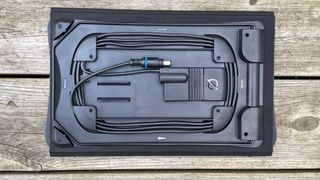
One thing we didn't like much about the Nomad 20 was its Solar Port cable, which is only useful if using it with a portable power station. It doesn't have a role to play if you just want to recharge a smartphone or two. Luckily, the cable can be coiled around the structure on the back of the solar panel, but it's a bit of a messy solution. We think it would be better if the 8 mm cable was completely detachable so you can leave it at home when you don't plan to use it.
What we did really miss having a small battery attached built-in to the Nomad 20. It's something we got used to while reviewing the Biolite 10+, which was thus able to supply our gadgets with power when it was cloudy. That's not something the Nomad 20 can do. So perhaps the best way to use the Nomad 20 is by attaching a portable battery to its USB slot and then charging your gadgets from there. That way you're effectively making hay while the Sun shines so you can use it when it's cloudy – or at night.
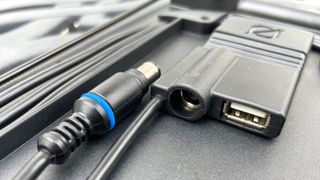
Goal Zero Nomad 20 solar charger review: alternatives to consider
There are an increasing number of rivals to the Nomad 20. In its own line-up there is Nomad 10 and Nomad 50, which offer 10W and 50W charging, respectively. BioLite sells some rivals, too, concluding the BioLite SolarPanel 5+ and BioLite SolarPanel 10+, both of which include a 3,200mAh on-board battery. Another option is the Powertraveller Kestrel 40, a slightly more powerful 12W solar panel with a huge built-in 10,000mAh battery.
Goal Zero Nomad 20 solar charger review: verdict
The Nomad 20 supplies a significantly high solar charge to gadgets while also being easy to use and of exceptionally rugged build quality. Its permanent 8mm cable means it's best thought of as an accessory to send 20W into a portable power station in a camp, but you can just as easily use it to send 10W into a smart phone or any other gadget that uses USB cable. Its lack of a built-in battery is a slight concern, but you can just supply your own and attach your gadgets to that, thus avoiding power cuts when it gets cloudy.


